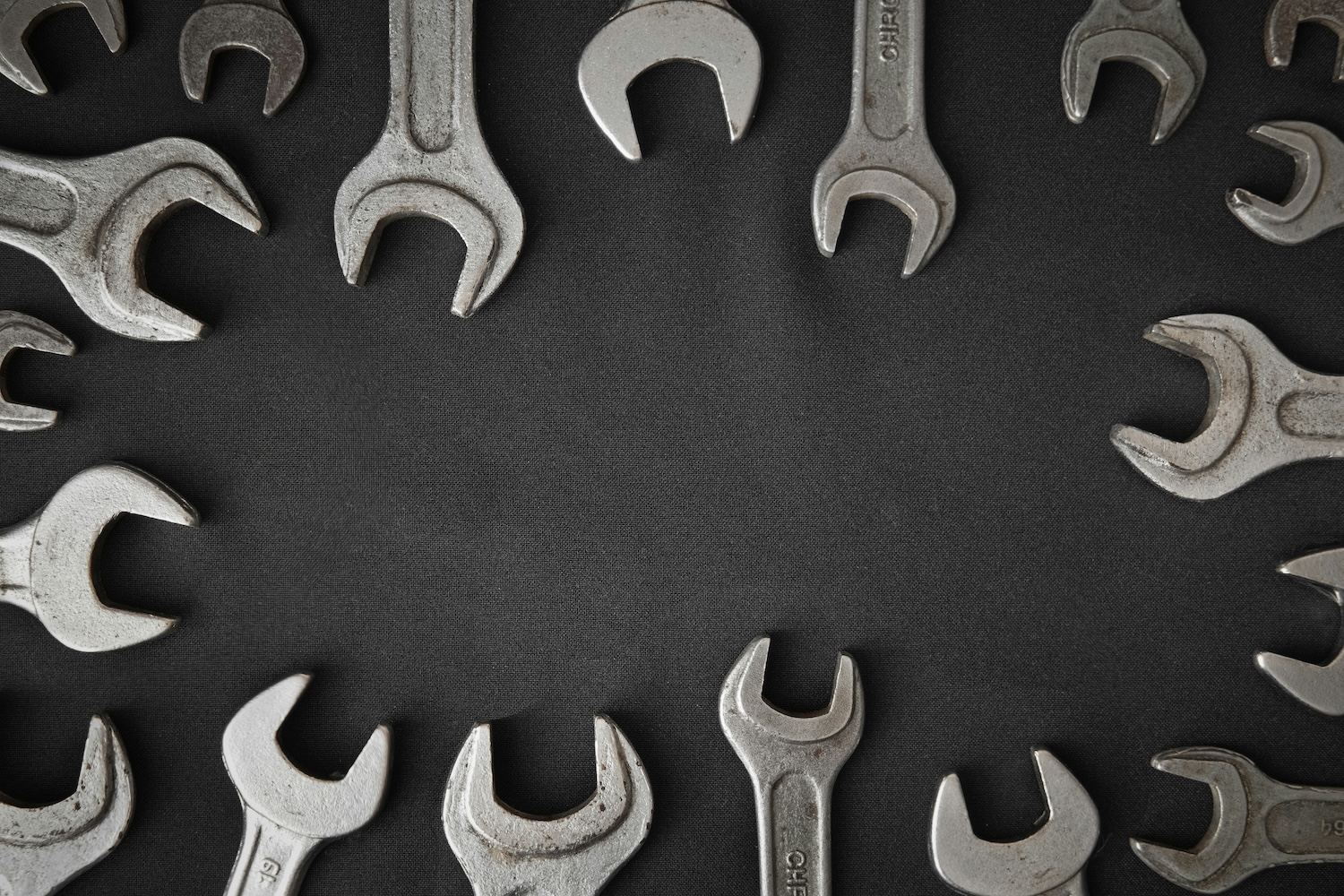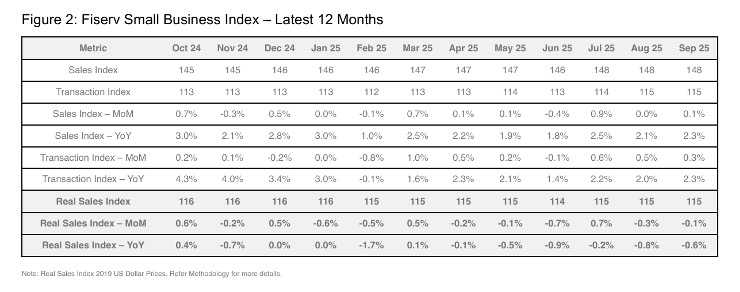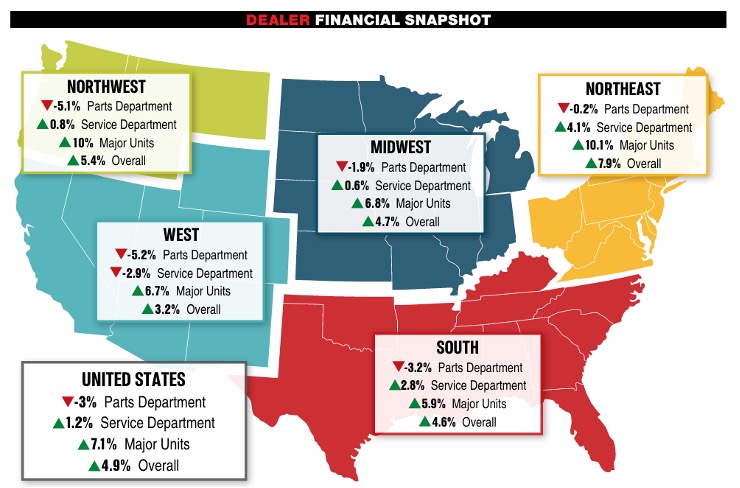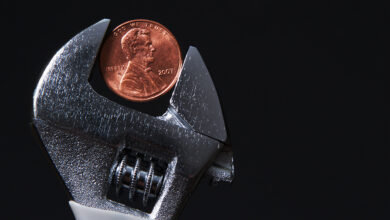
- KPI – October 2025: State of Business – Automotive Industry
- KPI – October 2025: State of Manufacturing
- KPI – October 2025: State of the Economy
- KPI – October 2025: Consumer Trends
- KPI – October 2025: Recent Vehicle Recalls
Consumer confidence and sentiment continue to ebb and flow, as tension and uncertainty remain high. The Fiserv Small Business Index held steady, but the NFIB Small Business Optimism Index dipped month-over-month (MoM)—exposing angst in rising inflationary pressures, slower sales expectations and ongoing labor market challenges. In the months ahead, all eyes are fixated on the economy—measuring job growth, analyzing tariff impacts and monitoring interest rates.
Nationally, the Fiserv Small Business Index “held steady” at 148 in September. Overall, sales increased 2.3% year-over-year (YoY) and a modest 0.1% month-over-month. In addition, the Fiserv Small Business Transaction Index rose to 115.0, with transactions advancing 2.3% year-over-year and 0.3% month-over-month. The Real Fiserv Small Business Index, adjusted for inflation, stood at 114.5 in September 2025—a 0.6% year-over-year and 0.1% month-over-month percentage decline.
According to the report, small businesses face growth challenges in Arts, Entertainment and Recreation (-1.8% MoM, -2.7% YoY), Transportation and Warehousing (-0.9% MoM, +0.9% YoY) and Retail (-0.3% MoM, +1.6% YoY).

Key Takeaways, Courtesy of The Fiserv Small Business Sales Index:
- Small business retail sales grew 1.6% year-over-year despite a sluggish performance month-over-month (-0.3%). In particular, Food and Beverage Retailers contracted 1.5% month-over-month and 0.1% year-over-year. Core Retail, which does not include volatile categories like Gasoline Stations, Motor Vehicle and Parts Dealers and Building Materials, dipped by 0.6%.
- Discretionary spending rose 1.5% year-over-year, but essential sales growth registered a faster pace at 2.9% year-over-year. “The overall slowdown in momentum across small business sales is evident as well, with discretionary purchases dropping to 0.1% month-over-month, while spending on essentials rose modestly by 0.3%,” according to the most recent report.
- Despite decreased foot traffic of 3.2% month-over-month, small business Hobby, Toy and Game Retailers increased sales by 2.2%. “Time will tell if this is a trend driven by tariff-induced price increases, or if consumers are simply spending more in anticipation of higher prices,” as noted in this month’s report.
- Bars and pubs posted a 1.1% uptick in monthly foot traffic, which drove increased sales growth of 1.6%. Full-service restaurants experienced a slight increase in foot traffic (0.2%) and much smaller monthly sales growth at 0.3%. Limited-service restaurants saw increased foot traffic of 0.4% with 0.1% sales growth.
- The Fiserv Small Business Index for Professional, Scientific and Technical Services in the U.S. increased by 7.2% year-over-year, while the Real Fiserv Small Business Index rose by 4.1% in its year-over-year percentage, indicating steady long-term growth. The Fiserv Small Business Index for Food and Beverage Retailers decreased by 1.5% month-over-month, while the Real Fiserv Small Business Index declined by 1.9%, highlighting a short-term trend. The Fiserv Small Business Transaction Index year-over-year percentage for Professional, Scientific and Technical Services increased by 9.1%, reflecting significant growth in foot traffic.
While small business America is holding strong, the sector certainly feels the pressure. In September, the NFIB Small Business Optimism Index declined two points to 98.8—the first decline in three months but above the survey’s 52-year average of 98. In particular, the Uncertainty Index jumped seven points from August. At 100, it is the fourth-highest reading in over 51 years.
“While most owners evaluate their own business as currently healthy, they are having to manage rising inflationary pressures, slower sales expectations and ongoing labor market challenges. Although uncertainty is high, small business owners remain resilient as they seek to better understand how policy changes will impact their operations,” says Bill Dunkelberg, NFIB chief economist.
Important Takeaways, Courtesy of NFIB:
- Data shows supply chain and inflation challenges were key pain points this month. The net percent of owners raising average selling prices rose three points to a net 24% (seasonally adjusted). A net 31% (seasonally adjusted) plan to increase prices over the next three months, up five points from August.
- Approximately 14% of owners reported inflation as the single most important problem in operating their business (higher input costs), up 3% month-over-month.
- Approximately 64% of small business owners reported supply chain disruptions were affecting their business to some degree, up 10% from a month prior.
- A net negative 7% (seasonally adjusted) of owners viewed current inventory stocks as “too low,” down 7%—the largest monthly decline in the survey’s history.
- Data shows actual earnings (the net percent of owners reporting higher vs. lower profits) increased 3%—up to its highest level since December 2021.
- The net percent of owners expecting better business conditions fell 11% to a net 23% (seasonally adjusted).
- Approximately 18% of small business owners cited labor quality as the single most important problem, down 3%, tying with taxes as the top single most important problem.
Professionals in the automotive, RV and powersports industries remain steadfast in their efforts to evolve their business models and grow their brands in the face of adversity. As such, the monthly Key Performance Indicator Report serves as an objective wellness check on the overall health of our nation, from the state of manufacturing and vehicle sales to current economic conditions and consumer trends. Below are a few key data points explained in further detail throughout the report.
Key Data Points:
- Economic activity in the manufacturing sector contracted for the seventh consecutive month, following a two-month expansion preceded by 26 straight months of contraction, say the nation’s supply executives in the latest ISM Manufacturing PMI Report. The Manufacturing PMI registered 49.1% in September, a 0.4% increase compared to the reading of 48.7% recorded in August.
- In September, the Consumer Price Index for All Urban Consumers (CPI-U) increased 0.3% on a seasonally-adjusted basis after rising 0.4% in August, according to the U.S. Bureau of Labor Statistics. Over the last 12 months, the all-items index increased 3% before seasonal adjustment.
- In September, the Global Light Vehicle (LV) selling rate remained “broadly in line” with the two prior months—holding at 94 million units per year. The market grew 7% year-over-year, as sales reached 8.1 million units globally. Approximately 67 million vehicles were sold year-to-date, up 5% from the same period in 2024.
- Total new-vehicle sales for October 2025, including retail and non-retail transactions, are projected to reach 1,249,800—a 6.9% year-over-year decrease, according to a joint forecast from J.D. Power and GlobalData.
- According to the quarterly forecast prepared by ITR Economics for the RV Industry Association (RVIA), RV wholesale shipments are projected to increase slightly by year-end to 337,000 units, then see continued growth to the mid-300,000 unit range in 2026.
- Powersports Business says dealers across the country reported an overall combined revenue incline of 4.9% year-over-year in August, according to composite data from more than 1,700 dealerships in the U.S. that utilize CDK Lightspeed DMS. On average, dealerships were up 7.1% in major units and 1.2% in service, but down 0.3% in parts.




